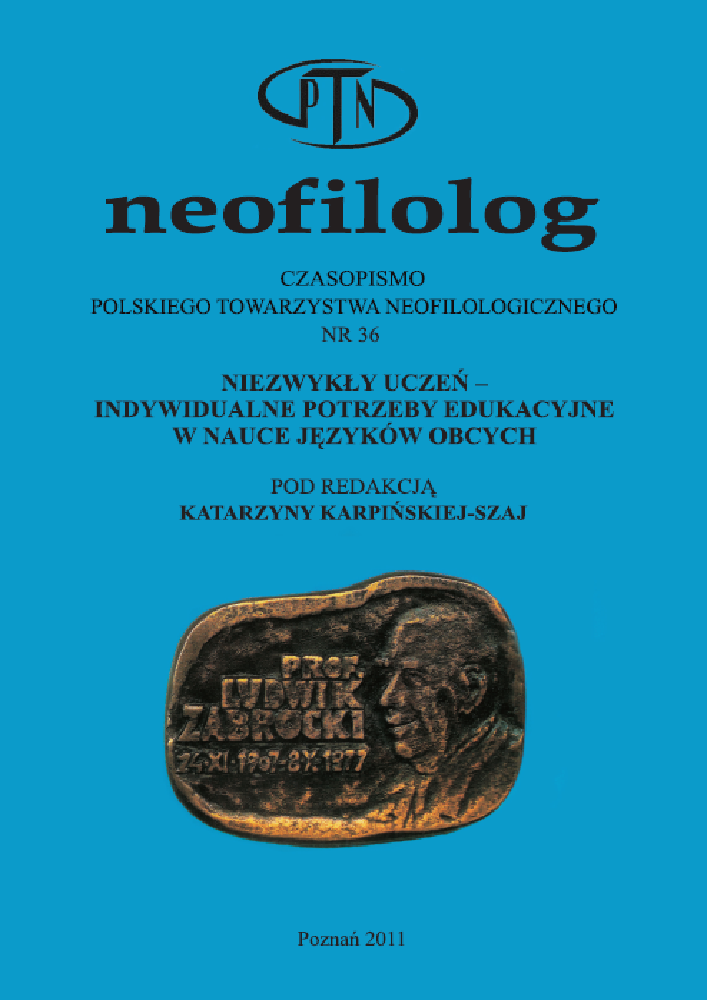Abstrakt
The paper focuses on the issue of special gifts of individuals with dyslex-ia. Many authors suggest that specific learning disabilities, like dyslexia, are connected with talents. Most often they point to the high level of vis-ual and spatial abilities. Unfortunately, the analysis of the findings of the available research shows that there is insufficient evidence that dyslexics are more creative and gifted than other people.
Bibliografia
Adelman, K. A. i Adelman, H. S. 1987. „Rodin, Patton, Edison, Wilson, Einstein: were they really learning disabled?”, Journal of Learning Disabilities 20 (5), 270-279.
Everatt, J. 1997. „The abilities and disabilities associated with adult developmen-tal dyslexia.” Journal of Research in Reading 20, 13-21.
Thomas, M. 2000. „Albert Einstein and LD: an evaluation of the evidence”. Journal of Learning Disabilities 33 (2), 149-158.
Geschwind, N. i Galaburda, A. M. 1985. „Cerebral lateralization. Biological mechanisms, associations, and pathology: I. A hypothesis and a program for research”. Archives of Neurology 42, 428-59
Grant, D. 2001. That’s the way I think – dyslexia and creativity, Referat wygłoszony na: British Dyslexia Association Conference, Londyn 2001.
Jorgensen, B. 1999. Dyslexia and Creativity, Źródło: http://hjem.get2net.dk/dyslexia /creativity.htmp, DW: 15.02. 2008,
Krasowicz-Kupis, G. 2006. „Dysleksja a rozwój mowy i jezyka”, w: Krasowicz-Kupis, G. (red.). Dysleksja rozwojowa – problemy teoretyczne. Gdańsk: Harmonia, Gdańsk. 53-70.
Krasowicz-Kupis, G. 2008. Psychologia dysleksji. Warszawa: Wydawnictwo Naukowe PWN.
LaFrance, E. B. 1997. „The gifted/dyslexic child: Characterizing and addressing strenghts and weaknesses”. Annals of Dyslexia 47, 163-182.
Łockiewicz, M. 2010. Przyswajanie języków o różnym stopniu transparentności a sprawność czytania dzieci w wieku wczesnoszkolnym praca doktorska przygotowana pod kierunkiem prof. dr hab. Marty Bogdanowicz w Instytucie Psychologii Uniwersytetu Gdańskiego
Nijakowska, J. 2007. Understanding Developmental Dyslexia. Łódź: Wydawnictwo Uniwersytetu Łódzkiego.
Rak, K. 2006. Wybrane cechy funcjonowania psychospołecznego u młodzieży z dysleksją rozwojową. praca doktorska przygotowana po kierunkiem dr hab. prof. nadzw. Grażyny Krasowicz-Kupisw Instytucie Psychologii UMCS.
Rawson, M. 1986. „The Many Faces of Dyslexia”. Annales of Dyslexia 36, 179-191.
Rourke, B. P. 1989. Nonverbal learning disabilities: The syndrome and the model. New York: Guilford Press.
Rourke, B. P. 1998. „Significance of Verbal-Performance discrepancies for sub-types of children with learning disabilities: opportunities for the WISC-III”. w: Prifitera, A. i Saklofske, D. (red.) WISC-III. Clinical Use and Interpretation. Scientist-Practitioner Perspectives. San Diego: Academic Press. 140-156.
Sartori, G. 1987. „Leonardo DaVinci Omo Sanzo Lettere: A case of surface dysgraphia?”. Cognitive Neuropsychology 4, 1-10.
Silverman, L. K. 1989. „Invisible gifts handicaps”. Roeper Review 12(1), 37-42.
Silverman, L. K. 2002. Upside-down brilliance: The visual spatial learners. Denver: CO: DeLeon.
Snowling, M., 2001. Dyslexia. Second Edition. Oxford – Malden: Blackwell Pub-lishers Inc.
Stein, J. F., Talcott, J. B. 1999. „The Magnocellular Theory of Dyslexia”. Dyslex-ia 5, 59-78.
Tresman, S., Cooke, A., Vose, K. 2006. The Dyslexia Handbook. London: British Dyslexia Association.
Von Karolyi, C., Winner, E., Gray, W., Sherman, G. 2003. „Dyslexia linked to talent: Global visual-spatial ability”. Brain and Language 85, 3, 427-431.
West, T. 1991. In the mind’s eye. New York: Prometheus Book.
Winner, E. i Karolyi, C. 1998. „Giftedness and egalitarian education: A zero sum?” National Association of Secondary School Principals Bulletin 82, 595, 47-60.
Winner, E., von Karolyi, C., Malinsky, D., French, L., Seliger, C., Ross, E., We-ber, C. 2001. „Dyslexia and visual-spatial talents: Compensation vs. defi-cit model”. Brain and Language 76, 81-110.
Wolff, U., Lundberg I., 2001. Dyslexia and artistic talents among university students, Referat wygłoszony na: British Dyslexia Association Conference, Londyn.
https://www.ortograffiti.pl; DW: 15.02. 2008
Licencja
Prawa autorskie (c) 2011 Grażyna Krasowicz-Kupis

Utwór dostępny jest na licencji Creative Commons Uznanie autorstwa – Bez utworów zależnych 4.0 Międzynarodowe.
Przedstawiany utwór (artykuł) upubliczniany jest na podstawie umowy z autorem i na licencji Creative Commons Attribution-NoDerivatives 4.0 International (CC BY-ND 4.0).
Użytkownicy mają obowiązek podania wraz z rozpowszechnionym utworem, informacji o autorstwie, tytule, źródle (odnośniki do oryginalnego utworu, DOI) oraz samej licencji;
- bez tworzenia utworów zależnych,
- utwór musi być zachowany w oryginalnej postaci.
Uniwersytet im. Adama Mickiewicza w Poznaniu zachowuje prawo do czasopisma jako całości (układ, forma graficzna, tytuł, projekt okładki, logo itp.).
